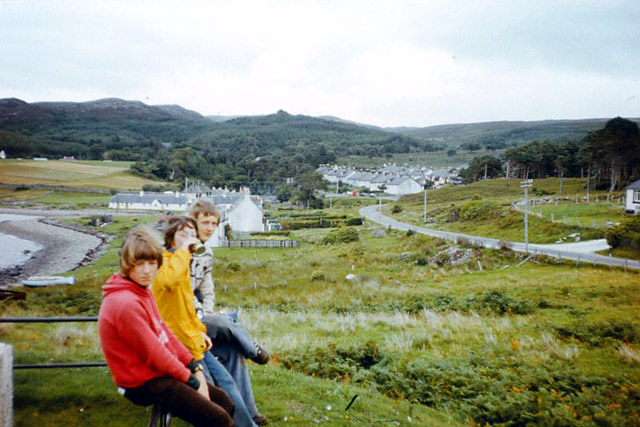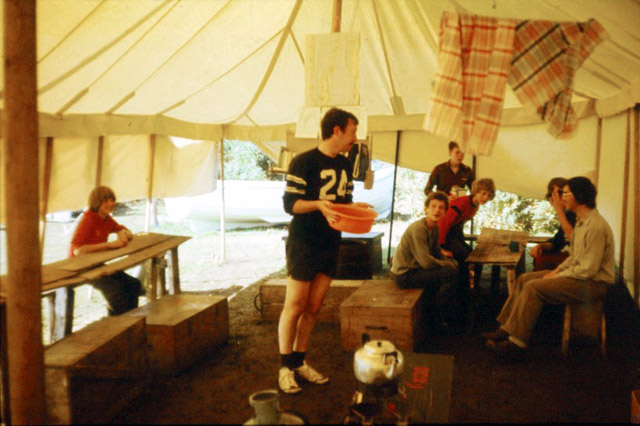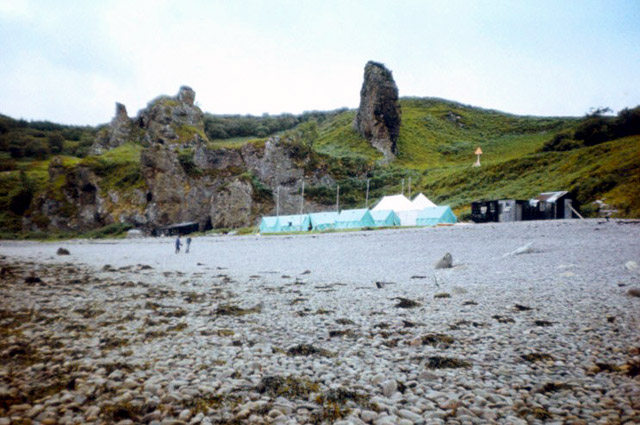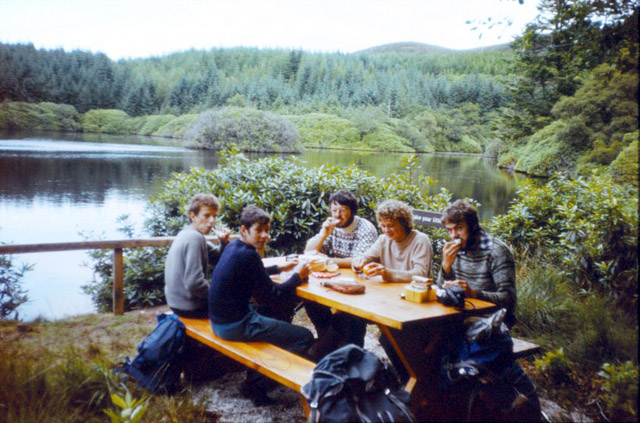![]()
![]()
Raasay 1978
| LEADER:- Roger Weatherly | |||
|
ASSISTANT LEADERS: Roger
Butler, Mike Dodge, Jon Gooding, Paul Hillman,
Alan Howard, Neil Hyde, Chris Venning, Richard Young. |
|||
|
MEMBERS: Tim Chappell, John Clayton, Quentin Elvidge, Rob Greenwood, Denis Hetier, Mark Jacombe, Jim McCarthy, Neil Marshall David Mason, Michael Meier, Tim Ratcliffe, David Rolinson, Simon Salt, Andrew Smith, Adrian Thomas, Peter Thorpe, David Thorpe, Stuart Walker, Ian Williams, Mark Woods, Richard Young. |
|||
|
|
|
||
|
In this group photo Roger Weatherly looks like a pirate! Alan Howard is in orange on the back row and to the left of him (partly hidden) is another officer - Mike Dodge. |
|||
|
LEADER'S REPORT I can say without any doubt that Raasay '78 was the wettest expedition I have ever been on; we had one properly sunny day. But on that day we scored a 'first’ for the Society - a half hour radio broadcast was recorded on location. This was later put on Radio 4 all over Britain on 18th October, and part of it was repeated on 'Pick of the Week’. It was a great experience, not only because Derek Cooper was so accommodating, but because the members responded splendidly to the occasion. No-one can say what ‘expedition spirit’ is, but we certainly had it! The leaders were partly responsible for this, and I want to thank them all for being a fine team; everyone was very tired at the end of the expedition and the reason was the leaders' unflagging commitment to the expedition and the members. But what of the members? Listening to the broadcast tape I near time and again, "Before I come I couldn't do this .... now I can". Who can value such growth and added confidence? No-one can cause them to happen - but when they do we are deeply affected, and we rightly feel our experience is the richer. I think we all knew the privilege of this specially 'Hebridean’ experience on Raasay. But philosophy apart (!) - what did we do? For a start there were six bivvies, which took quite a bit of doing. We also rounded up Calum's sheep, swam, played football, climbed, watched birds, walked endlessly, canoed, studied shore-line pollution, and entertained the village children for twenty-four (hectic) hours. As always on Raasay we were overwhelmed by the kindness of the islanders, especially Calum Macleod, Mrs. Rutherford and Mr. and Mrs. Hohler. While we may have felt that we were somehow launching an invasion, we found ourselves received as welcomed guests! It was fortunate that we had good canvas, for there was a nasty south-easterly gale which could have flattened the camp. The site is beautifully sheltered from the north and west, but faces east almost at sea level: Brochel Castle, some fifty feet above us on the cliff, must have been a miserable dwelling with the wind in this quarter. The sea was interesting too - in the morning it might be still and lifeless, but by 3.00 pm the shingle could be roaring up and down the beach. Inevitably the changeability of the weather limited our canoeing. However, in some respects it suited the ornithologists. The reversal of the wind brought in some interesting birds, and the generally low cloud gave us good, if fleeting, views of eagles and other birds of prey. Seals and otters were also visible from time to time. Climbing was probably the most exciting activity - Neil and later Chris led this to great effect. Many people tackled it for the first time, and everyone enjoyed it. As Blake wrote (though not perhaps with this in mind) 'Great things are done when men and mountains meet’. Another activity which must be recorded is Rob's tremendous piece of engineering at the Hohler’s cottage - the flight of stone steps must be the most durable (and possibly the most welcome) memorial we have ever left. One more thing must be said, for there is a sadder side to Raasay life and we experienced this too. We were moved as Calum recalled the ninety inhabitants at the north end early in the century; today he is almost alone. We remembered in our quieter moments that the solitude and peace we enjoyed had been paid for in the past, sometimes with much suffering. As we wandered one evening through the ruins at Screapadal, within view of our campsite, I know my mind turned to those who had once lived there - who doubtless had also seen otters and heard the sea on the shingle. What would they make of us? Taking a last look at our site when the transitory camp had gone, and seeing the obvious respect everyone had shown - no litter, no damage, no initials carved I imagined I heard them say 'Well done” - or were they my own words in the wind? Roger Weatherley |
|||
| Photos from Roger Butler. | |||
|
|
|||
|
The camp site below the ruins of Brochel Castle. |
|||
|
|
|||
|
|
|||
|
Wash day, Roger Weatherly and Alan Howard having fun with a box of washing powder. |
|||
| Some more photos from Roger, uploaded 04/12/2019. | |||
|
|
 |
||
|
Officers Neil Hyde and Jon Gooding |
Inverarish - a visit to the village on Raasay |
||
 |
 |
||
| View over Brochel - the camp can be seen by the pebble beach | Alan Howard | ||
 |
 |
||
|
Beach and camp below the ruins of Brochel Castle |
Loch a' Mhuilinn near the south end of Raasay |
||
|
|
|||
|
On the tidal isle of Fladday with South Rona beyond |
|||